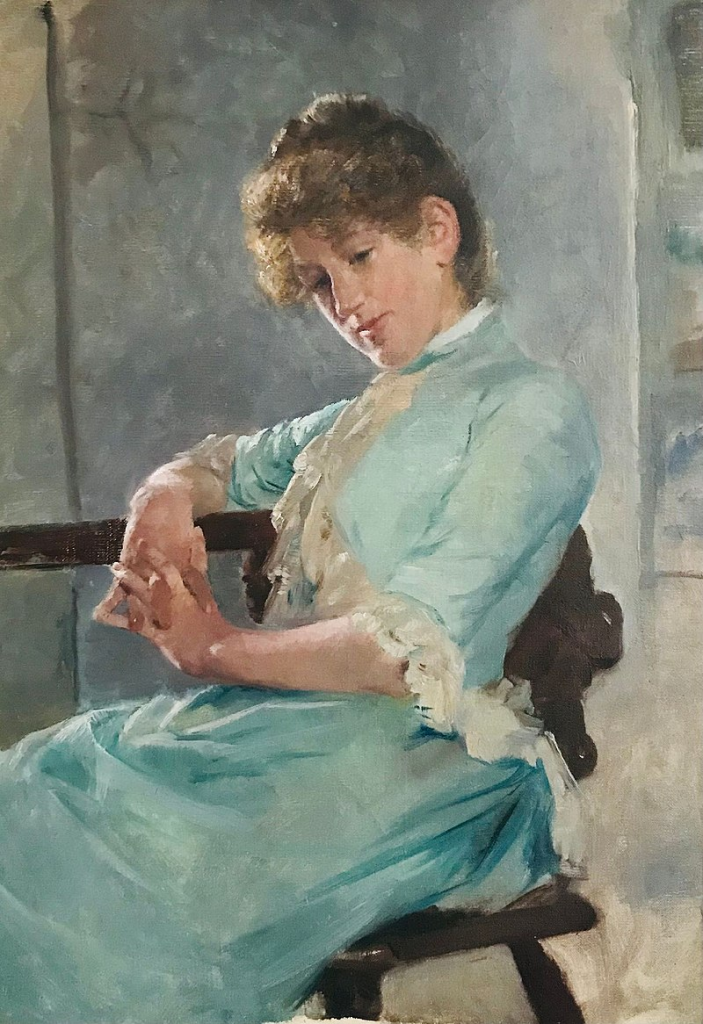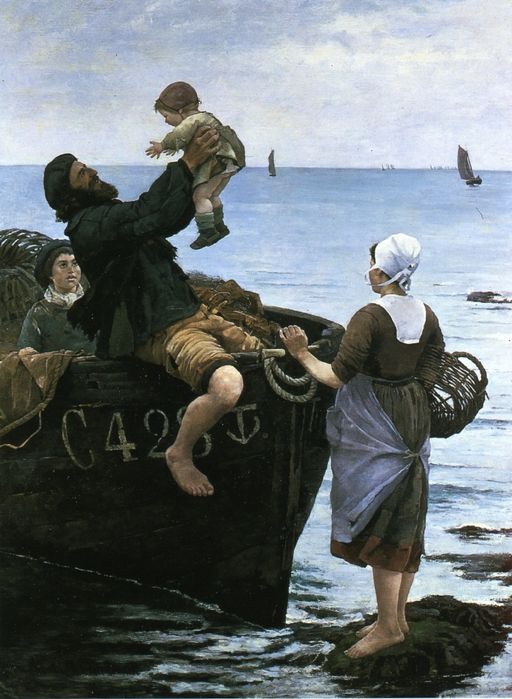The artist I am looking at today was one of several successful Swedish female artists who spent time studying in Paris during the 1880s. Her artwork was displayed every year at the great Paris Salons as well as in Sweden. Let me introduce you to Emma Hilma Amalia Löwstädt-Chadwick.
Portrait of Emma by her husband by Francis Brooks Chadwick
Emma Hilma Amalia Löwstädt was born in Stockholm on August 10th, 1855. Her father was Carl Rudolf Löwstädt, a well-off and well-respected businessman whose successful business acumen had made him one of Stockholm’s leading tailors. Rudolf was a fervent and active communist, who had adopted his political stance during his time as an apprentice in Paris where he had become friends with the philosopher Etienne Cabet. Emma’s mother was Carolina née Nordqvist. Emma’s paternal grandfather was Carl Theodor Löwstädt, a painter of miniatures, an illustrator, and a lithographer.

Eva Löwstädt-Åström portrait by her sister Emma Löwstädt-Chadwick
Emma Löwstädt was the second eldest of five children. Her mother Carolina died when Emma was just nine years old, a few weeks after she had given birth to her youngest child, Eva. Eva later went on to also become a well-known artist, Eva Löwstädt-Åström.

French landscape shepherd with pigs by Emma Lowstadt Chadwick
Emma loved to paint and draw as a young girl and her father, who had once hoped to become a painter, encouraged her in her artistic pursuits. His support and his financial resources meant that he could help his daughter, not just financially, but also through assisting her in every way he could whilst she resided abroad. Emma started her artistic education at the Technical School, then studied at the Royal Swedish Academy of Fine Arts in Stockholm from 1874 to 1880.

Interior with woman by Emma Lowstadt Chadwick
Her classmates included aspiring, and soon to be well-known, artists such as Julia Beck, Carolina Benedicks-Bruce, Eva Bonnier, Mina Carlson-Bredberg, Karin Larsson, and Jenny Nyström. Emma shone as a student, gained approving attention for her artwork and won many prizes in the annual competitions held by the Royal Swedish Academy of Art.
Off to Sea by Emma Löwstädt-Chadwick
During the summer of 1879 Emma spent time on the Breton coast where she was able to practice the new French trends of Impressionism and painting en plein air. Her motifs included flocks of sheep, at the seaside as well as depicting the lives of people who lived in the northern coastal towns of France. This style of painting which Emma embraced was so different from what she had been taught and had practiced at the Royal Swedish Academy of Art.

Beach Parasol, Brittany (Portrait of Amanda Sidwall) by Emma Löwstäd (1880)
One of her most famous paintings whilst she was travelling around the towns on the Brittany coast was entitled Beach Parasol, Brittany (Portrait of Amanda Sidwall), which she completed in 1880. It depicted her friend Amanda Stilwell painting en plein air on the beach. Amanda Sitwell, like Emma, had studied at the women’s department of the Royal Swedish Academy of Arts and then gone to Paris to continued her studies under Tony-Robert Fleury at the Académie Julian.

The Card Party by Emma Löwstädt-Chadwick
In 1880 Emma Löwstädt-Chadwick returned to Paris from Brittany and enrolled at Académie Julian, which, at the time, was one of the few private schools which accepted female students. Emma’s teachers were Jean-Charles Cazin and Tony Robert-Fleury. During her first year as a student one of her paintings was accepted for display at the Paris Salon, This, to her, was a great achievement, as all artists fought to get their work accepted at such a prestigious event. Acceptance was a form of recognition, which could lead to public mentions as well as gold and silver medals. Her paintings were accepted at the Salon every year throughout the 1880’s and into the 1890’s and her works would be at the Salon as late as in 1924. In 1887 she received special mention at the Salon for her painting entitled Five o’clock tea.
Woman and Child by Emma Löwstädt-Chadwick
Emma Löwstädt, after completing her studies at Académie Julian in Paris, travelled south to the village of Grez-sur-Loing. Beautiful landscapes had always played a prominent part in the artistic education of the painter and Grez had that beauty in abundance. Grez-sur-Loing had once been an artistic retreat for American and British artists during the latter years of the 1870’s, but later became the focal point for the Scandinavian, although predominantly Swedish, artists. From 1880 until the turn-of-the-century, the colony at Grez-sur-Loing thrived, providing an abundant source of inspiration for Swedish artists, all of whom sought an escape from the hustle-and-bustle of life in the French capital.

Portrait of her husband, Francis Chadwick by Emma Löwstädt-Chadwick
It was whilst living in Grez-sur-Loing that Emma met the wealthy Bostonian painter, Francis Chadwick , who was an important and innovative figure in the American art world in the late nineteenth century. Chadwick was a portrait, figure and landscape painter, and he became part of the expatriate American art community at Grez. Emma and Chadwick eventually fell in love and in 1882 the couple married.
Pension Laurent in Grez-sur-Loing by Elias Erdtman (1886)
They had a house built there and later purchased Pension Laurent, which was one of only two boarding houses in Grez-sur-Loing. Emma’s husband was a wealthy man which allowed the couple to live a carefree life, and they travelled together on many painting-trips to a variety of countries such as America, Spain, North Africa, Italy, and Great Britain, providing new motifs for Emma Löwstädt-Chadwick’s paintings.

Resting by Emma Löwstädt-Chadwick
Emma Löwstädt-Chadwick had her work exhibited at the World’s Fairs held in Paris in 1889 and in 1900 and she received an “honourable mention” in 1889 for her painting entitled Fångvakterska. More of her work appeared at the World’s Fair in Chicago in 1893 part of a group exhibition by twenty Swedish female artists exhibiting there in The Women’s Building. With her husband she lived an expatriate artistic life moving between Cornwall, London and France, where they spent much time with the artists’ colony at Grez sur Loing.

Emma Löwstädt-Chadwick depicted in Swedish Journal, Idun nr 50, 1892.
In later life, she had transitioned from painting to etching and her graphics were popular with Parisian collectors. Her motifs for her etchings were much the same as for her painting: genre pictures with peasants and fishermen and quiet interiors, but she also executed a series of very suggestive Paris images.
The Young Mother by Emma Löwstädt-Chadwick
In 1885, Emma Löwstädt-Chadwick was one of 84 artists who signed up to the Opponentrörelsen (Opponent Movement), a protest against the stultified Royal Swedish Academy of Art and its teaching methodology. The protest group was led by Ernst Josephson and in 1885, the members submitted their written demands to the Royal Swedish Academy of Fine Arts for a modernization and reform of art education, exhibition activities and support for artists. The demands were rejected by the Academy and so the group formed the the Konstnärsförbundet (‘the Artists’ Association’) and the following year, Emma Löwstädt-Chadwick joined the group and took part in several of their exhibitions.

Sleeping Child by Emma Löwstädt-Chadwick
My favourite painting by Emma is her 1885 work entitled Sleeping Child. Emma has managed to capture the sleeping figure in an immediate and moving manner. In a way, it is a study of the vulnerability of small children in our culture. Emma Löwstädt-Chadwick, through the medium of her paintings, wanted to study the home, human relations and our basic need for mutual recognition. It is truly a beautiful depiction of an innocent child.

Portrait of a Girl (thought to be one of her daughters) by Emma Löwstädt-Chadwick
Emma Löwstädt-Chadwick died in Avignon on January 2nd 1932, aged 76.










More Stories
Chinese Zodiac Signs
There’s A Pecan On My Desk
The Most Colossal Collection of Shakespeare Memorabilia